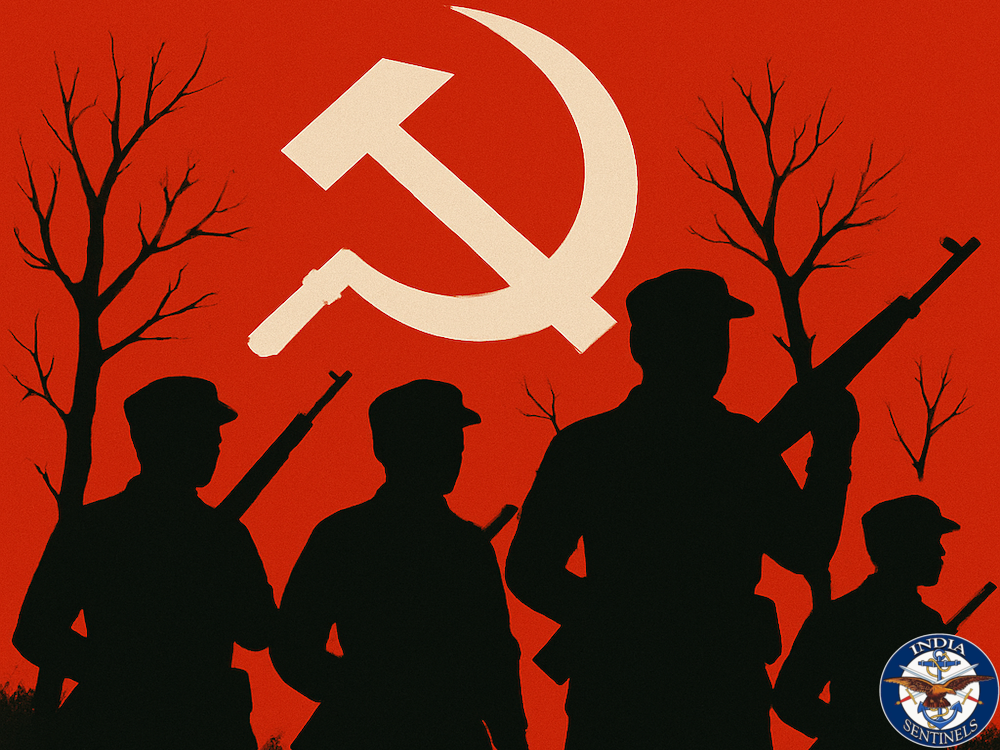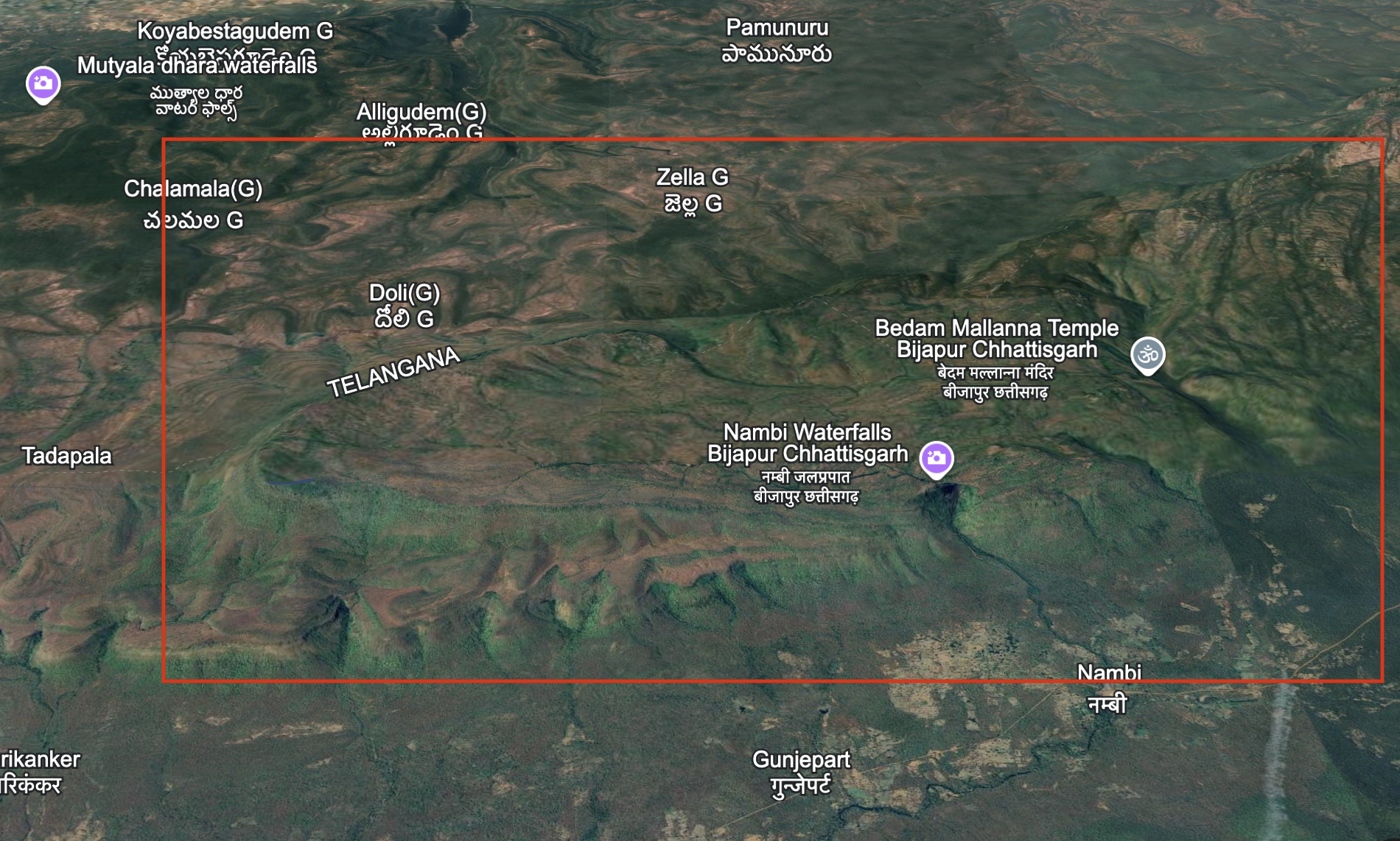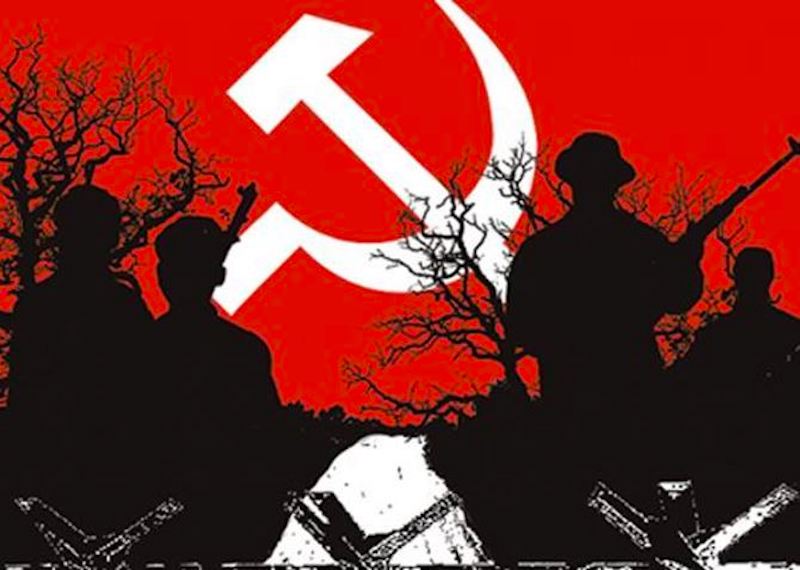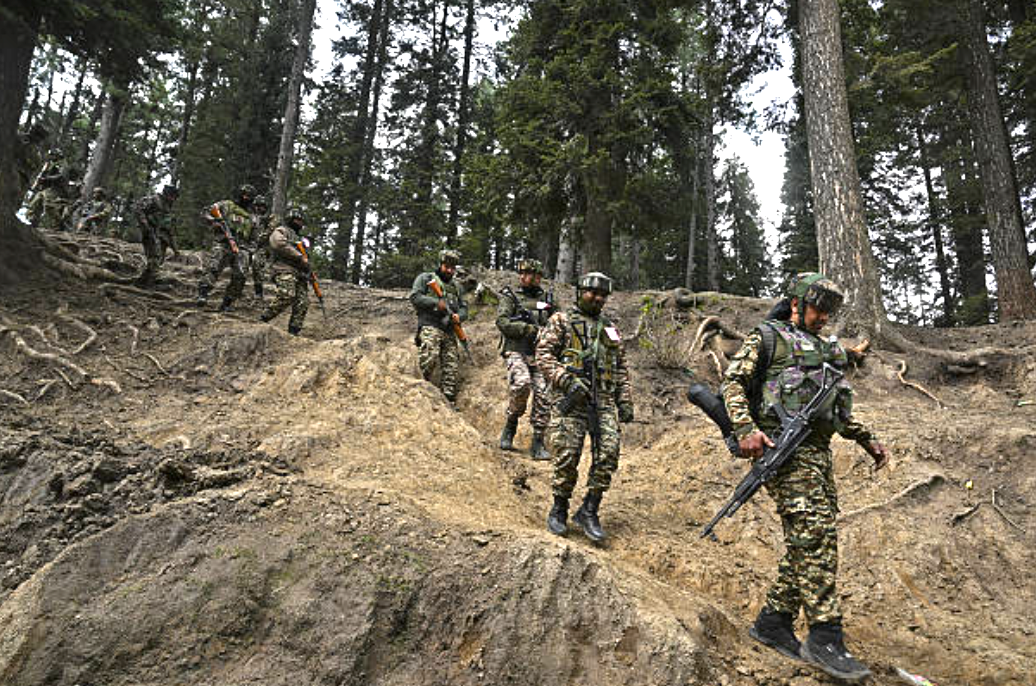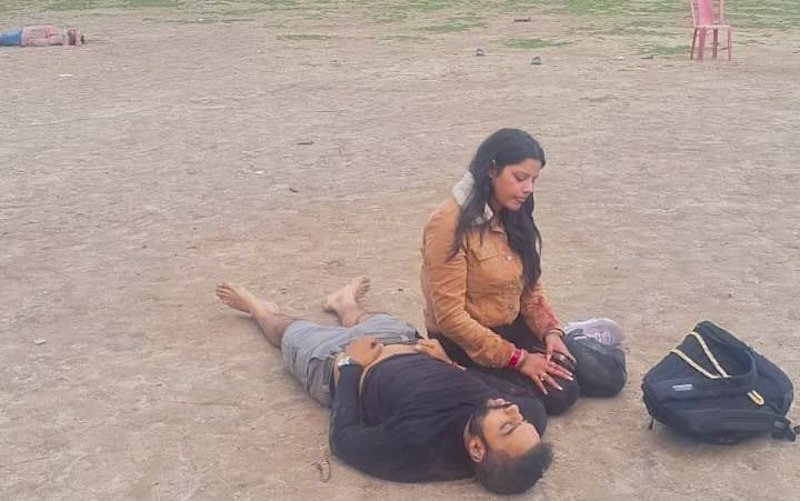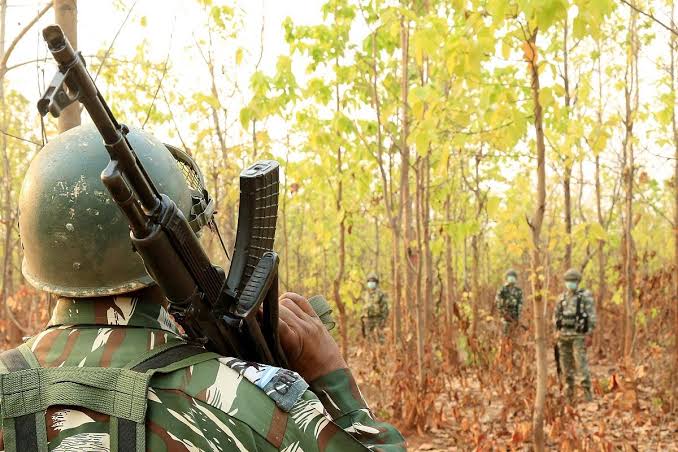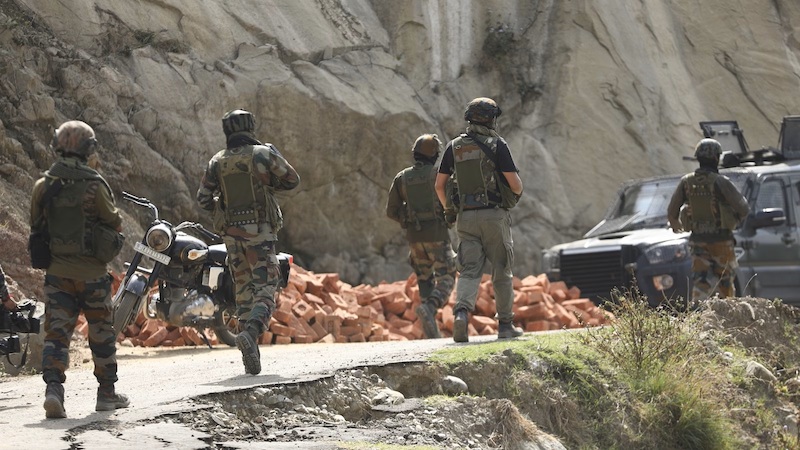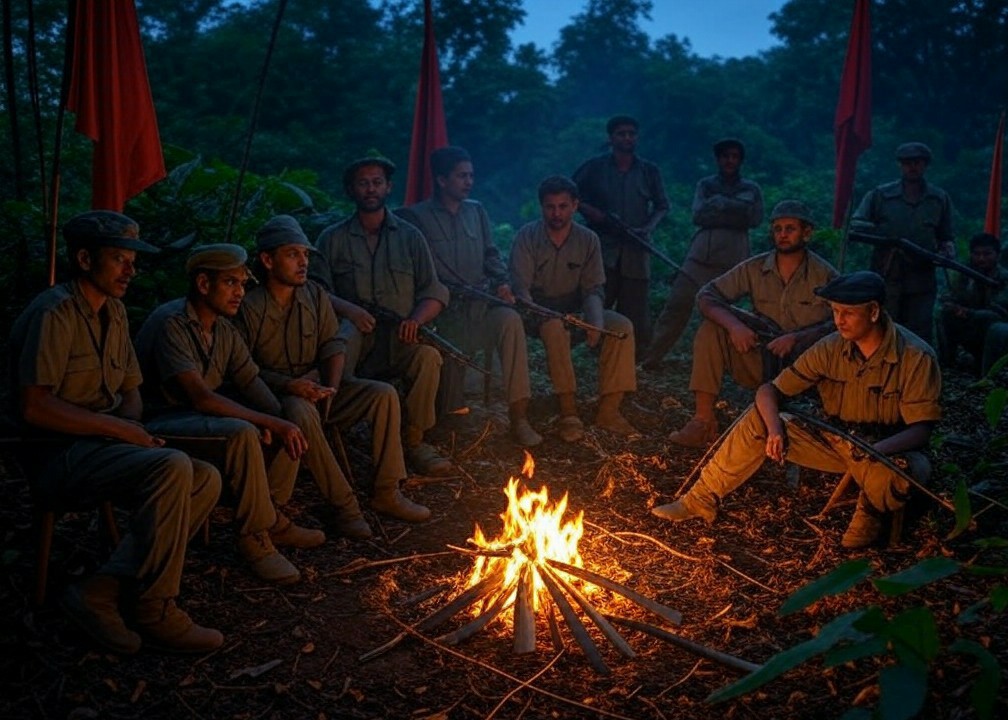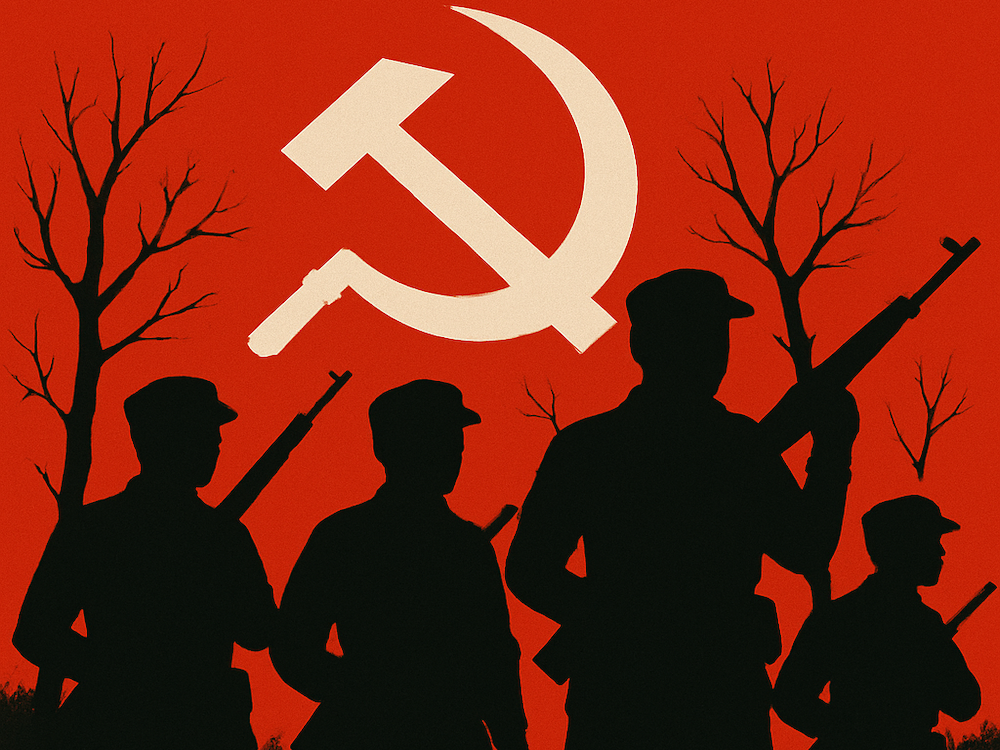 India Sentinels illustration for representation. (© India Sentinels – 2025)
India Sentinels illustration for representation. (© India Sentinels – 2025)
New Delhi: India’s decades-long battle against left-wing extremism reached a decisive moment this week with the elimination of Nambala Keshav Rao, alias Basavaraju, the general secretary of the banned Communist Party of India (Maoist). This marks the first time in three decades that a top-ranking Maoist leader has been neutralized by security forces.
The meticulously planned operation in Chhattisgarh’s dense Abujmarh (also spelled Abujmadh or Abujmad) forests resulted in the deaths of 27 Naxalites. This represents more than a tactical victory – it signals a potential turning point in the country’s fight against an insurgency that has claimed thousands of lives since the 1960s.
Security experts and government officials are describing this development as the “beginning of the end” for the Naxalite movement. The success comes as part of the Centre’s declared mission to eliminate the insurgency by left-wing extremists by March 2026, with continuous operations across left-wing extremism-affected states yielding unprecedented results.
Read also: Defeating Naxalism by March 2026 is an achievable target
Security Forces Score Major Victory
The week beginning May 19 marked a watershed moment in the country’s anti-Naxalite operations, culminating in the elimination of the country’s most wanted Maoist leader. The District Reserve Guard (DRG) of Chhattisgarh Police, working on precise intelligence inputs, launched a carefully coordinated operation in the forests along the Narayanpur-Bijapur border.
The operation began on Tuesday evening, with security forces cordoning off a 10-kilometre radius in the dense Abujmarh region – a traditional Maoist stronghold. Intelligence officers revealed that the operation was launched after local inputs indicated that members of the People’s Liberation Guerrilla Army (PLGA) Company Number 7 were spotted near Boter village.
 An AI-enhanced old and blurry photo of Nambala Keshav Rao, alias Basavaraju.
An AI-enhanced old and blurry photo of Nambala Keshav Rao, alias Basavaraju.
This elite unit, comprising approximately 35 fighters, was specifically assigned to protect the party general secretary and other top central committee members. The 26 Maoists killed alongside Basavaraju were all members of this protection detail, highlighting the significance of the intelligence breakthrough.
The encounter unfolded in two phases. Basavaraju initially escaped the first gunfight on Tuesday evening before being cornered in a second encounter approximately four kilometres away. Security forces had strategically positioned themselves to prevent any escape routes, which demonstrated the tactical sophistication that has come to characterize recent anti-Naxalite operations.
The final gunfight occurred before the crack of dawn at around 3am on Wednesday. Basavaraju’s body was identified only several hours later by surrendered Maoist cadres.
Read also: Restrategizing anti-Naxalite operations is key to end Maoist insurgency
Among the significant recoveries were 12 automatic weapons and three underbarrel guns, which revealed the heavy armament that the Maoist protection detail carried. The operation also resulted in the death of Jangua Naveen, a member of the special zonal committee, which further depleted the Maoist leadership structure.
The state director general of police, Arun Dev Gautam, confirmed that all 27 Maoists killed in the operation have been identified – a major breakthrough in intelligence gathering that would provide crucial guidance for future operations.
Fatal Blow to Maoist Movement
The week’s success was not limited to this single operation. In a separate encounter in Chhattisgarh’s Bijapur district, security forces engaged Maoists in the Tumrel village area, resulting in the gunning down of one Naxalite. However, the operation also claimed the life of a CRPF’s CoBRA commando.
The ongoing operation involved the 210th Battalion of Central Reserve Police Force’s Commando Battalion for Resolute Action (CoBRA) unit, along with troops from Chhattisgarh Police’s DRG and Special Task Force (STF). An Indian Air Force helicopter was pressed into service to evacuate the injured, which reflected the coordinated response capabilities that security forces have developed.
The elimination of Basavaraju represents far more than the loss of a single leader – it constitutes what security experts are calling a potentially fatal blow to the organizational structure and ideological backbone of India’s Maoist insurgency.
The Union home minister, Amit Shah, characterized Basavaraju as the “backbone of the Naxalite movement.” This remark underscored the magnitude of this achievement. Basavaraju had been with the movement since the late 1970s and was considered one of its most feared strategists. The 70-year-old Naxalite leader carried a bounty of ₹1.5 crore on his head.
Basavaraju’s Leadership
Basavaraju’s rise to the position of general secretary of the CPI (Maoist) in 2018, replacing Ganapathy (Muppala Lakshman Rao), marked a significant shift in Maoist strategy from political mobilization to aggressive militarization.
Former director general of police RK Vij, who played a crucial role in forming Chhattisgarh Police’s DRG unit in 2015, emphasized that Basavaraju was not merely a guerrilla commander but the ideological and military head of India’s most potent insurgent force. Under his leadership, the Maoists reorganized their armed units and centralized decision-making to counter state surveillance and force penetration.
The strategic importance of Basavaraju’s elimination becomes even more apparent when considering his role in some of the deadliest attacks on Indian security forces. Security officials believe he was the mastermind behind the 2010 Dantewada attack – one of the most devastating assaults on Indian forces, which resulted in the deaths of 76 CRPF jawans.
His involvement in the 2018 killings of Telugu Desam Party MLA K Sarveswara Rao and former MLA Sivari Soma in Andhra Pradesh demonstrated his continued operational influence across multiple states.
Impact on Organization
The impact of Basavaraju’s death on the Maoist organizational structure is already becoming evident. With his demise, the Maoists’ strength has shrunk to just two bureaus due to significant intelligence gains by security forces.
The Chhattisgarh Police’s Bastar Range inspector general, P Sundarraj, noted that Basavaraju had a direct or indirect role in all Maoist attacks in left-wing extremism-affected states over recent years, making his elimination a crucial disruption to the movement’s operational capabilities.
The chief minister of Chhattisgarh, Vishnu Deo Sai, assessed Basavaraju’s killing as the “proverbial last nail in the coffin of Naxalism” – reflecting the confidence among security and political leadership that this operation marks a decisive turning point.
The loss of such an experienced leader, combined with the elimination of his entire protection detail, has created a significant vacuum in the Maoist command structure that will be difficult to fill. The centralized decision-making structure that Basavaraju had implemented to counter state penetration now works against the movement, as his death has severed crucial communication and coordination links across different Maoist units.
Sustained Success Against LWE
The elimination of Basavaraju and his protection detail represents the culmination of a sustained campaign by the country’s security forces that has achieved unprecedented success in recent months, as India Sentinels had been reporting. The government’s declaration to end the Naxalite insurgency by March 2026 has been backed by continuous operations across left-wing extremism-affected states.
Security forces have demonstrated remarkable tactical improvement and intelligence coordination. The Bastar region in Chhattisgarh, which remains the core area of Maoist operations, has witnessed particularly intensive security operations that have systematically dismantled Naxalite infrastructure.
Enhanced Capabilities and Tactical Evolution
The success of operations like the one that eliminated Basavaraju reflects the enhanced capabilities of specialized units, such as the CoBRA and DRG. These elite jungle warfare units within the CRPF play a key role in leading operations in LWE-affected states.
These units have been specifically trained and equipped for anti-Naxalite operations, with their expertise in jungle warfare proving crucial in penetrating traditional Maoist strongholds like the Abujmarh forests.
The tactical sophistication demonstrated in recent operations marks a significant evolution in India’s counterinsurgency approach. The methodical strategy of cordoning off large areas and positioning forces to prevent escape routes has become characteristic of current anti-Naxalite operations. This strategic planning, combined with improved intelligence gathering and coordination between different security agencies, has enabled forces to achieve sustained pressure on Maoist leadership and operational capacity.
Intelligence: The Game Changer
Intelligence gathering has emerged as perhaps the most crucial factor in recent successes. The operation against Basavaraju was launched based on local intelligence that members of PLGA Company Number 7 were spotted near Boter village.
This demonstrates the effectiveness of ground-level intelligence networks that security forces have developed. The ability to identify and track elite Maoist units like the general secretary’s protection detail represents a significant advancement in intelligence capabilities that has fundamentally altered the balance of power in the insurgency.
The systematic targeting of Maoist leadership and infrastructure has created a cascading effect that is degrading the movement’s overall capabilities. With the reduction of Maoist strength to just two bureaus, the movement’s ability to coordinate large-scale attacks and maintain territorial control has been severely compromised.
This degradation of organizational capacity, combined with the loss of experienced leaders like Basavaraju who possessed decades of insurgency experience, has left the movement struggling to maintain coherence and operational effectiveness.
Strategic Defeat or Temporary Setback?
Despite the massive setbacks the Maoists have suffered this year, the question of whether recent successes represent their strategic defeat or merely a temporary setback has become a central focus of analysis among security experts and policy observers.
The elimination of Basavaraju, combined with the systematic degradation of Maoist capabilities over recent months, suggests that the movement is facing its most serious existential challenge since its inception in the 1960s. However, the complex socio-economic factors that have sustained the insurgency for over five decades indicate that achieving a permanent victory will require more than military success alone.
However, the structural challenges facing the Naxalite movement may suggest that current setbacks may indeed represent a strategic defeat rather than a temporary pause. The loss of experienced leadership like Basavaraju, who possessed four decades of insurgency experience and institutional memory, cannot be easily replaced.
The centralized command structure that he implemented to counter state penetration has become a vulnerability. His death has disrupted crucial coordination mechanisms across different Maoist units. The shrinking of the movement to just two bureaus represents a dramatic reduction in organizational capacity that will be difficult to rebuild.
Expert analysis indicates that the current phase of counterinsurgency operations has achieved unprecedented penetration of Maoist strongholds and leadership structures. The government’s systematic approach, combining improved intelligence capabilities with tactical innovation and sustained pressure, has created conditions that make it extremely difficult for the Maoists to reconstitute their organizational strength.
Underlying Conditions Remain
However, the underlying socio-economic conditions that have historically sustained the Naxalite movement remain largely unchanged in many affected regions. The “Red Corridor” continues to encompass 18 districts across seven states, predominantly in areas with low human-development index (HDI) scores and high poverty rates.
These regions remain characterized by dependence on primary sector activities, lack of land ownership among the majority population, and limited access to basic services like electricity, running water, and healthcare. The absence of effective state presence in many of these areas historically allowed Naxalites to establish themselves as legitimate authorities by providing social services and infrastructure.
Experts who have studied the factors that led to the rise of the Naxalite movement widely agree that the government’s strategy for ensuring permanent victory must extend beyond military operations to address these underlying conditions. Development initiatives that improve access to education, healthcare, and economic opportunities in affected regions will be crucial for preventing the resurgence of support for extremist ideologies.
Land reforms that address historical grievances of tribal communities, combined with policies that ensure equitable sharing of benefits from natural resource extraction, could eliminate many of the socio-economic drivers that have sustained the insurgency.
The success of current counterinsurgency operations provides an opportunity to implement comprehensive development programmes in areas that were previously inaccessible due to Maoist presence. The government’s ability to leverage this security success into lasting peace will depend on its capacity to deliver tangible improvements in the lives of affected communities.
Without addressing the root causes that made these regions susceptible to Naxalite influence, there remains a risk that future socio-economic pressures could create conditions for the insurgency to regenerate, albeit possibly in different forms. Even international experience with counterinsurgency operations demonstrates that military success must be accompanied by political and economic solutions to achieve lasting victory.
The Centre’s approach to consolidating its current gains against the Naxalite movement will therefore be crucial in determining whether recent successes represent a permanent strategic defeat or merely a temporary disruption.
What’s Next?
The security forces’ recent tactical victories against the Naxalite movement, culminating in the elimination of Basavaraju and the systematic degradation of Maoist organizational capacity, represent a potential watershed moment in a conflict that has persisted for over five decades. The combination of improved intelligence capabilities, tactical innovation, and sustained operational pressure has achieved unprecedented success in penetrating Maoist strongholds and dismantling leadership structures.
However, the ultimate success of the country’s counterinsurgency campaign will depend on the government’s ability to leverage these military gains into lasting political and economic solutions. The socio-economic conditions that have historically sustained the insurgency in the Red Corridor require comprehensive attention through development initiatives, governance reforms, and policies that address the legitimate grievances of affected communities.
The government must now focus on consolidating these gains through a multi-pronged approach. This includes maintaining security pressure on remaining Maoist elements while simultaneously accelerating development in liberated areas. Infrastructure development, particularly in education and healthcare, will be crucial for winning hearts and minds.
Economic opportunities through skill development programmes, promotion of small-scale industries, and better market access for agricultural produce can provide legitimate alternatives to the youth who might otherwise be attracted to extremist ideologies.
Only by combining continued security pressure with meaningful socio-economic transformation can India ensure that its current tactical victories translate into the permanent elimination of the Naxalite threat and the establishment of lasting peace in affected regions.
The death of Basavaraju may well mark the beginning of the end of India’s longest-running insurgency, but converting this tactical success into strategic victory will require sustained commitment to both security operations and development initiatives in the months and years ahead.
Follow us on social media for quick updates, new photos, videos, and more.
Twitter: https://twitter.com/indiasentinels
Facebook: https://facebook.com/indiasentinels
Instagram: https://instagram.com/indiasentinels
YouTube: https://youtube.com/indiasentinels
© India Sentinels 2025-26

